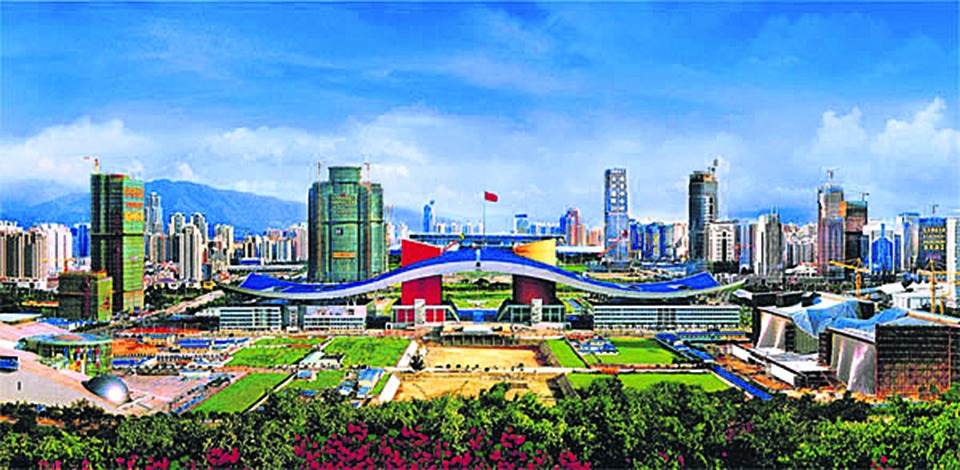
OR
URBANIZATION IN CHINA


Nick Maddock and Gloria Xiecun Li
Maddock is an adviser on livelihoods and employment at UNDP Nepal and Li is a student of economics at London School of Economics.news@myrepublica.com
More from Author
What can Nepal learn from Chinese urbanization? Planned urbanization was at the core of almost everything in China.
Over the last hundred years, Asia chased the urban dream. Dirt roads gave way to concrete, while glass covered high-rise, dwarfing ancient valleys and the cities rose up. China, in particular, grew incredibly fast, with industrialization and urban growth moving at stunning speed. Since the dawn of China’s economic reforms in 1978, mushrooming urban epicenters have lifted many out of poverty and improved livelihoods for hundreds of millions. China now hopes to share its successful urban experience through the Belt and Road Initiative (BRI) which will fund infrastructure on trade routes through neighboring countries.
What then can Nepal learn from this and why does Chinese urbanization matter to Nepal? In part of course because Nepal needs much higher rates of growth to meet the goal of emerging from Least Developed Country (LDC) status, as well as becoming a middle-income country. It is necessary to understand why China succeeded in growing so quickly and also how it has minimized the squalor that has been part and parcel of urban growth in so many Asian countries. Part of the answer is that, in opening up to the world, China rapidly morphed into market-oriented growth strategy. Yet planned urbanization stayed at the core of almost everything.
Planned urbanization
How can “planning” and “market” share the same sentence? In periods of fast development—from the 1980s to 2000s—Chinese planners went for concentrated yet decentralized growth. Concentrated because they never aimed at balanced growth across the country; decentralized because land and housing reforms helped local bodies drive growth. Cities on the coast experimented with export processing zones and new land laws. There was no private ownership of land, but local governments instead sold 50-70 year land leases. The housing and infrastructure that ensued brought revenues which enriched local governments, in turn, funding more urban development.
Tax policy meant land tax became the largest extra-budgetary revenue for local governments, giving them strong incentives to stimulate local growth. Armed with an abundance of funding, local governments then competed against each other to attract enterprise.
In this way, cities concentrated wealth, population and investment. They kept enterprise at their core, with infrastructure a major component, helping cities on the coast reap the benefits of export trade. Special Economic Zones, export processing zones, and free trade zones offered generous tax breaks and sanctuary from China’s domestic business environment. Foreign companies and joint ventures were established there, driving growth and employment, further boosting revenues of local governments.
The downside is that Chinese central and far western regions got little attention, at least until now. Safety nets prevented extreme poverty, pending an expected trickle down of wealth from the strong growth on the coast. But it was never expected that inland regions could compete with the prosperous coast. The Belt and Road Initiative now aims to tackle this by linking lagging regions to markets inside and outside China, with physical and enterprise infrastructure at the core, thereby mirroring the policies which led to the coastal boom.
But it’s of course not all rosy. Coordination is a problem. Multi-layered plans by different national agencies and ministries coexist alongside local governments’ separate visions, thereby threatening coherence. And there is still urban marginalization, albeit on a lower scale than elsewhere in Asia. To promote joined-up government, the city region entered the Thirteenth Five Year Plan. Government grouped smaller and medium-sized cities close to megacities into city regions, with each specializing in goods or service. This is not uniquely Chinese and the notion of city regions also forms part of European and American economic visions.
What Nepal can learn
What does this mean for Nepal? Like China, Nepal’s economy is very concentrated and urbanizing, arising mainly in Kathmandu, Pokhara and other smaller cities, including those on the open southern border with India. Does this matter? Probably not for now since development has never been equal, even in high-income countries, with concentration and agglomeration acting as driving forces in growth. There are also great opportunities, most obviously in the new provincial capitals, to plan urbanization and make it work for the people living in towns and for the enterprise development that Nepal so badly needs.
And, if Chinese experience is a guide, good planning will minimise urban sprawl and squalor for better human development, as well as unleash enterprise growth. The impending designation of the new provincial capitals thus provides the obvious trigger for growth-based urban planning, while also keeping human development as a core concern.
Overarching everything is inevitability of urbanization. Progress will no doubt disenchant, but intervening in urbanization to make it work for people and enterprise can lead to better outcomes in terms of economic and human development, as China has so firmly demonstrated.
Maddock is an adviser on livelihoods and employment at UNDP Nepal and Li is a student of economics at London School of Economics.
You May Like This

Boost investment in power transmission infrastructures
As Nepal strives to achieve uninterrupted power supply for all its citizens and capitalize on surplus electricity through exports, urgent... Read More...
_20201014060614.jpg)
Nepal abstains from voting as UNHRC adopts resolution against Sri Lanka's human rights record
KATHMANDU, March 23: Nepal has chosen to abstain from voting in the United Nations Human Rights Council on a resolution... Read More...

Party's name will be Nepal Communist Party after merger: Leader Nepal
KAILALI, Feb 9: CPN-UML leader Madhav Kumar Nepal said that the name of the new party after merger between CPN-UMLand... Read More...




Just In
- Kushal Dixit selected for London Marathon
- Nepal faces Hong Kong today for ACC Emerging Teams Asia Cup
- 286 new industries registered in Nepal in first nine months of current FY, attracting Rs 165 billion investment
- UML's National Convention Representatives Council meeting today
- Gandaki Province CM assigns ministerial portfolios to Hari Bahadur Chuman and Deepak Manange
- 352 climbers obtain permits to ascend Mount Everest this season
- 16 candidates shortlisted for CEO position at Nepal Tourism Board
- WB to take financial management lead for proposed Upper Arun Project






_20220508065243.jpg)








Leave A Comment